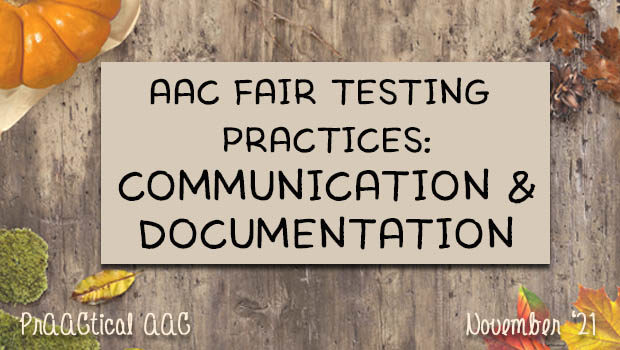AAC Fair Testing Practices: Communication & Documentation

We’re continuing to discuss strategies for helping teams devise ways to test students who use AAC in ways that allow them to show what they actually know in test-taking situations. For the most part, this involves team discussions and collaborative problem-solving to develop a plan based on each AAC user’s individual needs, abilities, and priorities.
Today’s post addresses two important topics: How individuals will communicate during testing and how teams document the ways that assessments are administered to a particular individual.
TOPIC 12
Communicating During Testing – How will students express themselves during testing?
People who use AAC should always have easy access to the tools they use for communication. In testing, professionals may be tempted to remove or restrict the AAC device during testing, but there are several reasons why this is not a good idea. For starters, we’re violating basic human rights in making communication aids less accessible. Beyond that, we’re probably impacting their performance in negative ways.
Without access to their communication device, individuals who use AAC will likely:
- Have difficulty asking for a break or other things that may help them function to the best of their ability;
- Be unable to convey basic physical needs, such as using the bathroom;
- Give directions and instructions, such as “I’m supposed to have a scanned copy so that I can do this on my computer” or “Check my IEP. I have testing accommodations that you need to know about;”
- Express nuanced feelings and internal states (e.g., “I feel really nervous about this.” “I’m starting to get nauseous”);
- Be unable to ask questions, such as “Can you say that again?”;
- Tell the examiner about problems (e.g., “It’s hard to see. Can you move it closer?” “My chest strap is digging into my shoulder and it hurts”);
- Feel singled out and discriminated against for being barred from communicating, a fundamental human right; and,
- Become more anxious as a result of the communication barrier we’ve erected.
Bottom line: Communication aids/devices need to be accessible at all times, including during assessment activities.
Another thing to consider is how the student will use their communication tools during testing. Teams should discuss how this applies in different assessment situations and develop a plan for letting the individual know of any rules that impact communication. For example, in high-stakes testing, students need to know that talking is not permitted except with the examiner.
Predictive text features are another thing that teams should discuss in advance, preferably with the input of the AAC user. Together, they may decide to limit access to those features in situations such as a spelling quiz, where the use of word prediction may well give us an inaccurate picture of the student’s spelling abilities.
TOPIC 13
Documentation of Adaptations to Testing Situations – How will adaptations to standard protocols be documented?
There are several reasons why documenting our experience with tests administered in non-standard ways is important. First, we want to be transparent and abundantly clear about the changes that were made so that others gain insight into the intentional process that we undertook. This gives other team members some context for interpreting the results.
Clear, accurate, and thorough documentation also provides team members with concrete ideas for better testing procedures for students who cannot take tests in standard ways. In reviewing the documentation, they may identify specific testing adaptations that can be used in assessments for all sorts of things. When Leisl’s teacher looked at the test booklet and read the ways that the SLP adapted the test, he immediately recognized things that could be done in the classroom to assess this student in more meaningful ways. He was able to develop similar procedures for assessing a range of academic skills and felt confident that Leisl’s answers were increasingly indicative of what she truly knew. After a while, he was able to use similar sorts of adaptations for other students in his classroom.
Most importantly, though, when we are rigorous in describing the changes that were made with and for a particular student, it becomes easier for people to replicate our process when re-testing that student. Because we are using the exact same procedures both times, we can look at the student’s performance over time to measure growth. It is always helpful to compare scores over time, but it is particularly beneficial here because the act of modifying tests and testing procedures invalidates comparisons to a normative sample. The only valid comparison is the students to themselves and the best way to do that is to ensure that the same procedures were used each time the test was administered. Those apples-to-apples comparisons are only possible when there is clear documentation about the adaptations.
What should be documented?
- A rationale for why changes were needed
- What specific changes to the test materials and/or test administration procedures were made
- Clear explanations of those adaptations with enough detail so that another professional could replicate the procedures
- Explicit acknowledgment that comparisons to the normative sample cannot be made (e.g., no age or grade equivalencies)
Where should these things be documented?
At a minimum, changes should be documented both on the test form/booklet/protocol and in the assessment report. They can also be described in the IEP and referred to in progress reports.
:::::::::::::::::::::::::::::::::::::::::::::::::::::::::::::::::::::::::::::::::::::::::::::::
Stay tuned for our next post in this series, which will focus on implementing AAC Fair Testing Practices.
You can see previous posts in this series using the links below
Filed under: PrAACtical Thinking
This post was written by Carole Zangari
